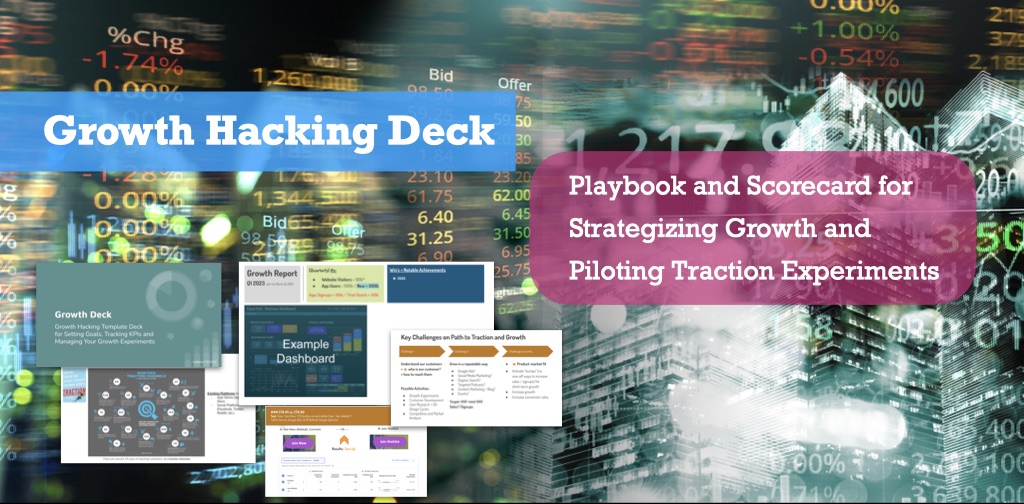Chinese military strategist Sun Tzu once wrote in “The Art of War”: “Strategy without tactics is the slowest route to victory. Tactics without strategy is the noise before defeat.”
Sun Tzu’s quote from over 2,500 years ago underscores the importance of both strategy and tactics in any endeavor. While a strategy provides a broad vision or direction, tactics are the specific actions or steps taken to achieve that vision. Without tactics, a strategy remains just an idea, untested and unvalidated. Conversely, tactics without battleharded, data-driven lessons and a guiding strategy can lead to aimless, even counterproductive actions.
In the realm of growth hacking and digital marketing, businesses need more than just aimless actions—they need actions informed by strategy and strategies that are actionable. The goal is to learn from each strategic move and let those learnings shape your subsequent actions and long-term initiatives.
Growth hacking a business, product or marketing demands a mindset like Sun Tzu’s and approach backed by data: a strategy aiming at overarching goals and uncovering key data-driven insights and learnings overtime through intentional, iterative, tactical actions.
But how to merge strategy with execution? How to attack your marketing, growth and product decision making with a framework and tool that combines data-driven strategizing with step-by-step actions and growth tactics? What’s the “secret” sause?
A approach that combines a way to build a data-driven strategy with step-by-step actions and tactics. Merging strategy with execution, growth hackers and startups need
Enter the Growth Hacking Deck, an dynamic, agile, action-orienting tool with frameworks, trackers, mental models, checklists and approaches for setting up, managing and tracking your growth and traction hacking experiments.
Whether you are just getting started or looking to systematize a workflow, the Growth Deck can help. It’s designed to navigate the intricacies of traction strategy with traction tactics and growth-enabling actions, ensuring that your ship sails smoothly even in turbulent and uncertainty waters.
🚀 Get the Growth Hacking Deck TEMPLATE for FREE now. View, Download, Copy key slides to starting tracking, growing and managing your growth initiatives.
I’m a data-driven growth hacker. Amongst various product and engineering roles, I have also worked extensively on the growth and data side at several startups and companies. Over the past couple years I’ve lead growth and marketing at several early-stage companies, including a healthtech app, two life science startups, a tour operator, an ecommerce shop and even a couple of of my own businesses and creative pursuits.
This is the deck, slides, and processes I’ve used to set up scaleable traction channels, increase conversion rates and drive growth through iterative, data-driven traction experimentation. It’s a practical, step-by-step guide to launch, manage and hone growth hacking strategy and tactics to reach sustainable busines model built to grow.
In this post, I’m going to share the key ideas behind this deck and my approach to data-driven growth hacking.
In today’s constantly evolving digital landscape, businesses require agile, dynamic tools that not only help in tracking growth but also in strategizing about it. The Growth Hacking Deck is my one-stop shop tool that blends strategy with execution, serving as both a roadmap and a performance report card for startups and for rapidly learning and scaling businesses.
Let’s walkthrough the main ideas and key slides as well as discover how this ‘playbook’ and ‘scorecard’ has become an indispensable asset for hacking traction and growth on a range of startups and products.
NOTE: This post is part of a blog series on growth hacking.
What’s the Growth Hacking Deck For? And Why Does It Matter?
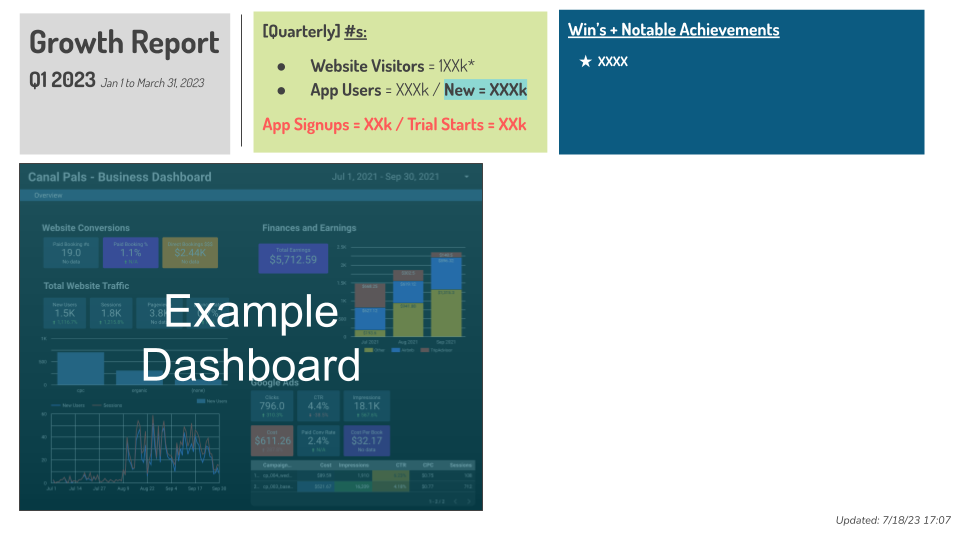
Your Growth Deck: Set Goals, Track Metrics and KPIs, and Manage your Traction Experiments.
A growth hacking deck is a visual and strategic tool designed for businesses, particularly startups and those in rapid growth phases. The aim is to align on growth objectives, track key metrics, manage, prioritize and executve on growth experiments. In turn, it can seamlessly help uncover and showcase learnings and results.
Unlike traditional marketing or business decks, a growth hacking deck focuses on doing rather than presenting. It’s a slide deck centered on iterative, data-driven experiments and tactics aimed at hacking growth and achieving sustainable and scalable growth. It serves as both a roadmap and a report card, emphasizing what we have done, results we achieved, what we have learned and what we want to try next.
To be honest though, it doesn’t matter whether you use the template I shared or even document and manage growth through slides. What matters is having a working doc and repository of mental models, data, knowledge, actions taken, lessons learned, and frameworks and ideas of what to do and try next.
Your growth deck consolidates separate systems and data into one place in an easy-to-read, check up on, comment, think-together format. It’s a living document for individuals and teams seeking to implement and reach a strategy and tactical approach for sustainable and scalable growth.
A growth hacking deck is a dynamic visual tool tailored for businesses, especially startups in accelerated growth stages. Beyond just presenting, it actively aligns growth objectives, tracks vital metrics, manages experiments, and emphasizes achieved results and future endeavors. Essentially, it acts as the crucial playbook and scorecard, bridging strategy with action for those pursuing robust growth.
Essential Components for Your Growth Deck
Before we look at specific slide and tracking recommendations as well as some of the frameworks provided, it’s important to ask ourselves: What is essential for tracking, managing and planning our growth?
In my opinion, it’s essential that your growth hacking deck includes three core elements:
- Your Vision & Goals
- A Summary or Overview of Your Growth Numbers
- Your Experiments & Latest Growth Campaigns with data and notes
- Growth Levers/Opportunities
Put another way, a growth hacker or growth team should always be be setting goals and prioritizing, tracking business-defined metrics and KPIs, documenting and tracking experiments and their results and considering new growth levers and opportunities.
Let’s look at each of them briefly and what they serve in your growth hacking process.
Your Vision & Goals
The “Vision & Goals” slide or slides is where set and state your objectives and goals. It serves as the foundation for your growth hacking process and deck and sets the direction and purpose for all subsequent slides.
Your Vision & Goals provides a clear expression of growth targets and/or learning goals. What are you hoping to learn with data? What do you want to try? What metric improvement are you aiming at? These are just a few questions you might consider for framing the specific growth goals you are working towards.
There is no exact what to articulate goals here. You might go with OKRs, you might be aspiration or quite specific and realistic. Here’s what I generally include:
- Vision Statement: A succinct and inspiring statement that conveys your company’s long-term desired change resulting from its ongoing efforts. It should articulate where the company sees itself in the future.
- EXAMPLE: “Empowering every individual to achieve their optimal health through innovative wellness solutions.”
- Mission Statement (optional)
- EXAMPLE: “To provide cutting-edge health tools and education that are easily accessible, user-friendly, and backed by science, ensuring our users have the resources they need to live healthier, longer.”
- Short-Term Goals: Clearly defined objectives you aim to achieve in the upcoming quarter or year. These should be SMART goals (Specific, Measurable, Achievable, Relevant, Time-bound).
- EXAMPLES: 1. Reach 100,000 active users by the end of Q2 2023. 2. Launch three new health tools by the end of 2023. 3. Achieve a 90% user satisfaction rate by Q2 2024.
- Long-Term Goals (optional): Objectives you aim to achieve in the next 3-5 years.
Feel free to include a few visual supports with your logo, customer or something inspirational here. This is ideally in the voice and vibe of the company.
Personally, what I’m looking for in the goals area is determining: What questions do you want to answer? What numbers do you want to improve? What lessons do you want to learn? What can you do to figure out and improve growth?
In practice, this could be just as succulent and pithy as create a sustantinable growth funnel for your product or service. For later stage business we might be seeking “lift” or improvement in a single channel or funnel, while a new startup or venture might need fuller end-to-end efforts.
Your Growth Overview Slides: What are my latest metrics?
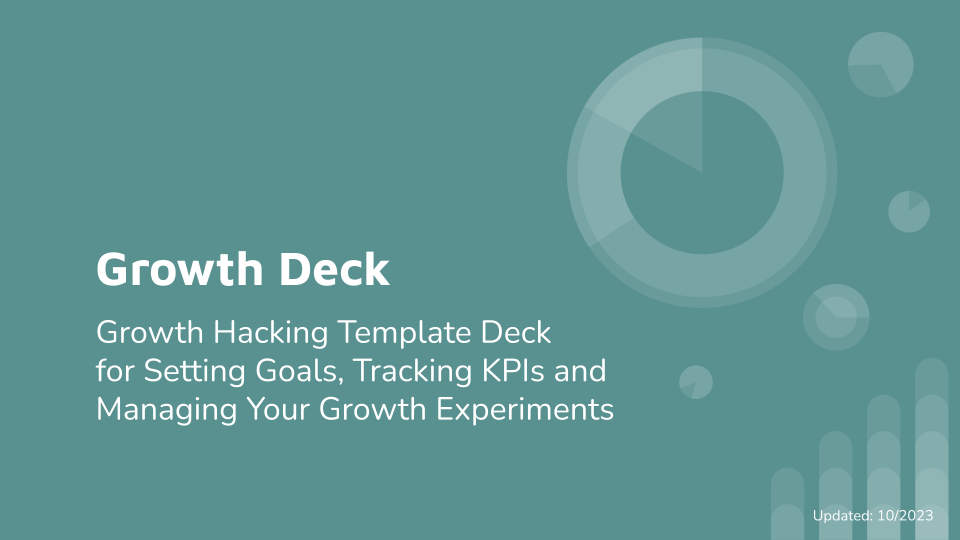
This is where you define your current metrics & KPIs.
Your Growth Overview Slides are the big scorecard for your business. It is there to state as objectively and as unambiguously as possible your current period’s growth and product success metrics. Ideally it should be immediately followed by a comparative period to quickly read trends in your numbers. .
Ideally using consolidated data from your traction dashboard, you should be able see latest overview numbers on either a monthly or quarterly scale and including last 2 or 3 quarters. It should include your essential KPIs and metrics as well as any noteable achievements.
An explainer and deep dive into growth metrics and KPIs is beyond this particular blog post and likely merits a separate write-up. Regardless, some things you likely want to track are:
- Acquisition Metrics - Where am I get new users or customers? And how much is it costing?
- Activation Metrics - From these inbounds, how many and what percent activate, convert, buy, etc.?
- Retention Metrics - From subscibers and new users, how many are staying active?
- $$$, Revenue, Total sales/downloads/subscriber/etc., costs
Slides for Your Experiments & Latest Growth Campaigns
These slides should be the practical and most used part of your growth deck and growth process. It’s here where you manage and track your growth and traction campaigns and experiments.
Slides for your Experiments & Latest Growth Campaigns should include comprehensive details of all growth experiments undertaken recently. Ideally compressed into just one or two slides per initiative, your growth deck should clearly show for each campaign:
- What you did - ideally try to visually explain/show changes you are making
- Your hypothesis or question
- The results or readout - Data you are seeing to determine success/failure/improvement/etc.
- Your takeaways, lessons learned, and or next steps.
Here are three quick examples:
1.> End-to-End Example from Ad to Landing Page to Lead Capture
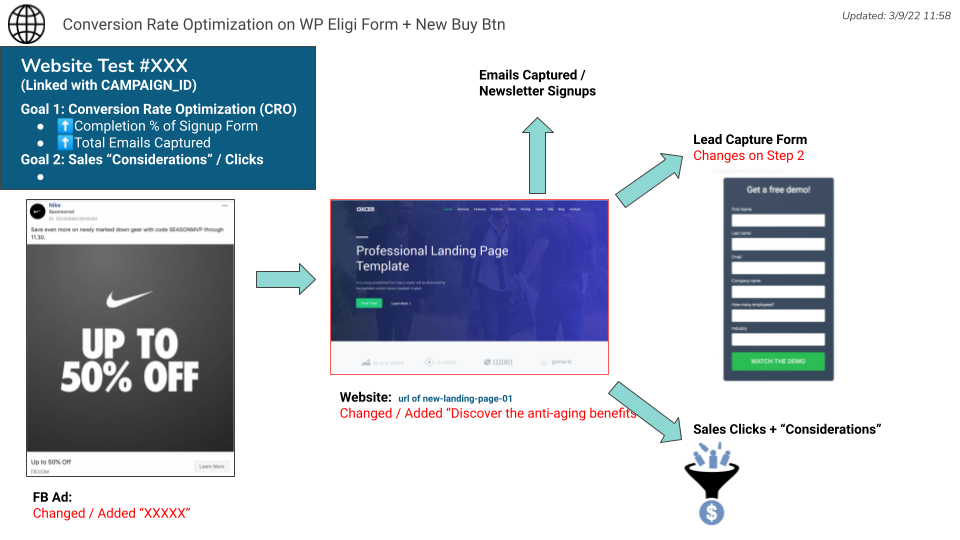
2.> Google Ads Experiment showing two headline options and a clear winner based on data
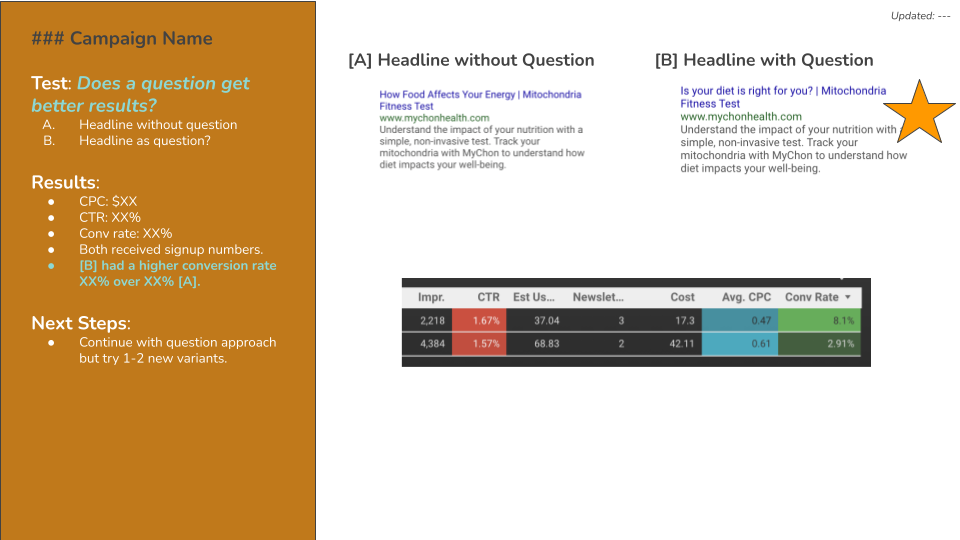
3.> Landing or Website A/B Test showing a null response on two CTA options.
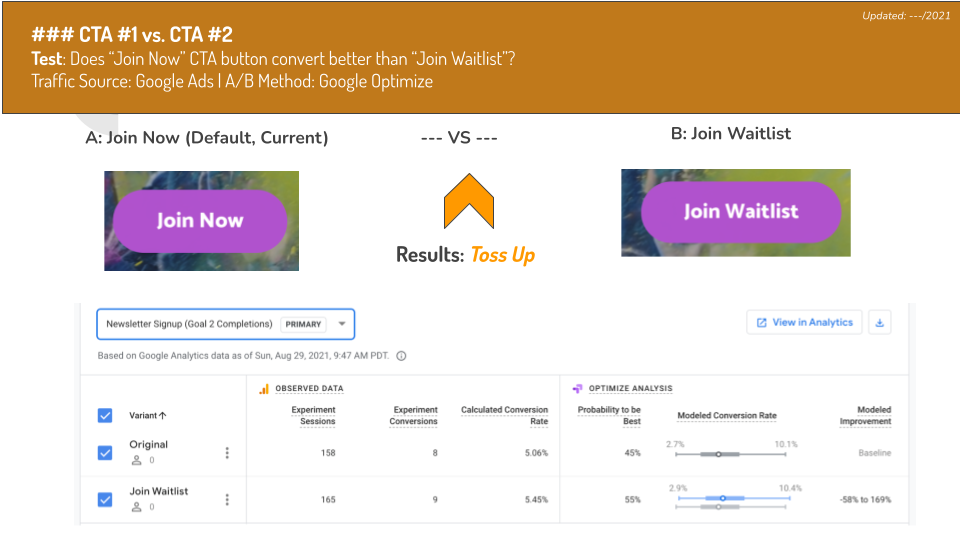
Growth Levers/Opportunities
Growth Levers/Opportunities: What channels are active or might potentially propel growth? Active, tried and prospective channels should be articulated and noted so you have got a clear roadmap towards scaleable growth.
The “Growth Levers/Opportunities” slide(s) are primarily there to outline and track the potential channels, tactics, or strategic areas a business can leverage or tap into to drive growth. There is not necessarily one-size-fits-all approach here since some of this will depend on your business or product.
But a good heuristic or rule of thumb for growth hackers is to consider:
- Potential Traction Channels - How can find and bring awareness to potential buyers or users of my product or services? What channels are active or might potentially propel growth?
- Growth Tactics - How can I enage, activate and convert potential customers? The options are limitless and potentially demand creativity and ingenuity but there are lots of obvious and tried-and-truth best practices to deploy and iterate on.
The thing to remember is that you sometimes need to ask questions of yourself and components of your business model like: Is my growth or product experience working? Can I continue to grow or sustain my business? Can I improve any of it?
There are often no simple answers when hacking growth, but there are processes and opportunities to pursue towards figuring them out. Your job is to ask questions and find ways to get the answer. Rinse and repeat.
Additional Slides and Growth Deck Tools
Beyond these core slides, here are a few additional slides I occassionally include. The goal is to have ways to figure out your stage and determine your next steps and possible opportunities to grow and improve.
Channel Comparison: What numbers are we getting from which channels?
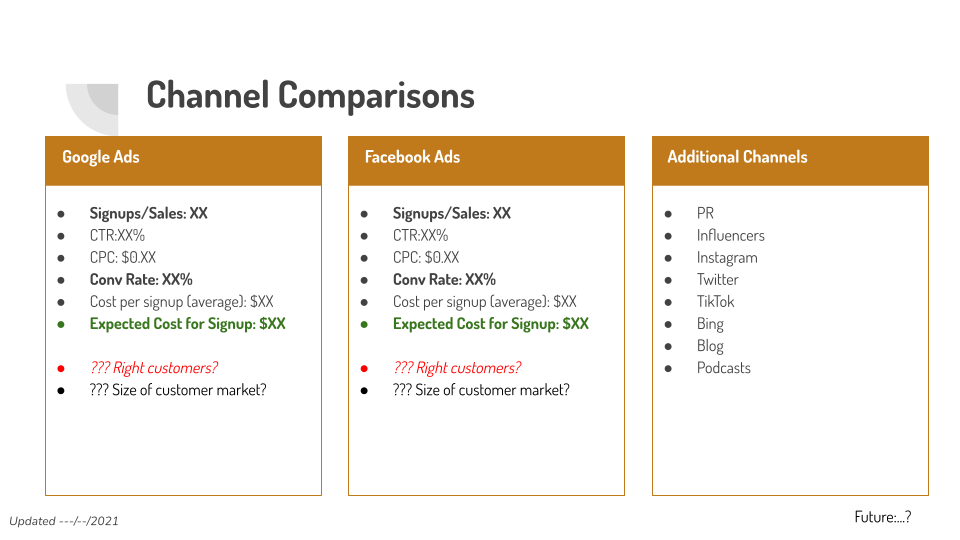
This slide is intended to put your key traction channels side-by-side for comparison. Ideally it should showcase compareable metrics like cost-per-event or converion rates. The goal is to give you a way to make data-driven decisions on strategy, growth tactics, and prioritization.
Experiments and Traciton Roadmap: What will we try? Where are we going?
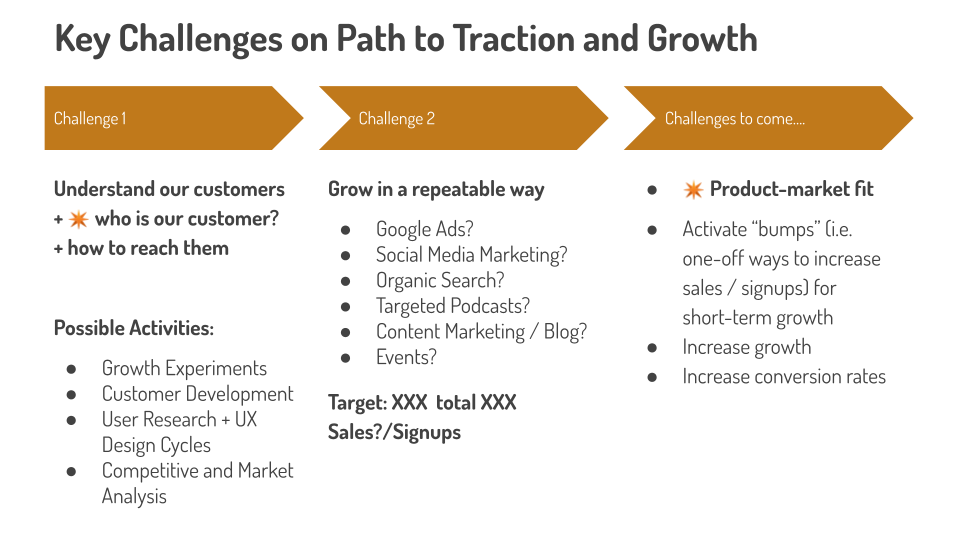
This slide is designed to see your growth path as a series of challenges and stages. It could be a simple bullet list. I like this breakdown that forces a certain questioning around where we are and where we should go.
Trying, Tracking and Attacking Your Traction Channels
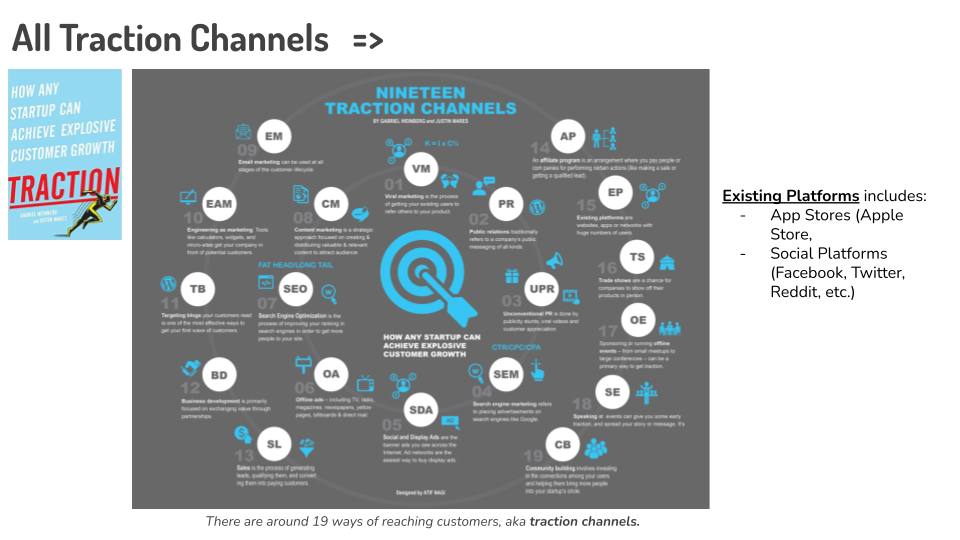
This this list of traction channels and method was developed by Gabriel Weinberg. His book “Traction” describes how to find, test and choose the best traction channels for any growth-oriented business, organization or startup. It’s must-read for growth hackers.
Basically what I do is use this big list of possible traction channels and then color code which we are active on, which we’ve tried and some potential someday-maybe options.
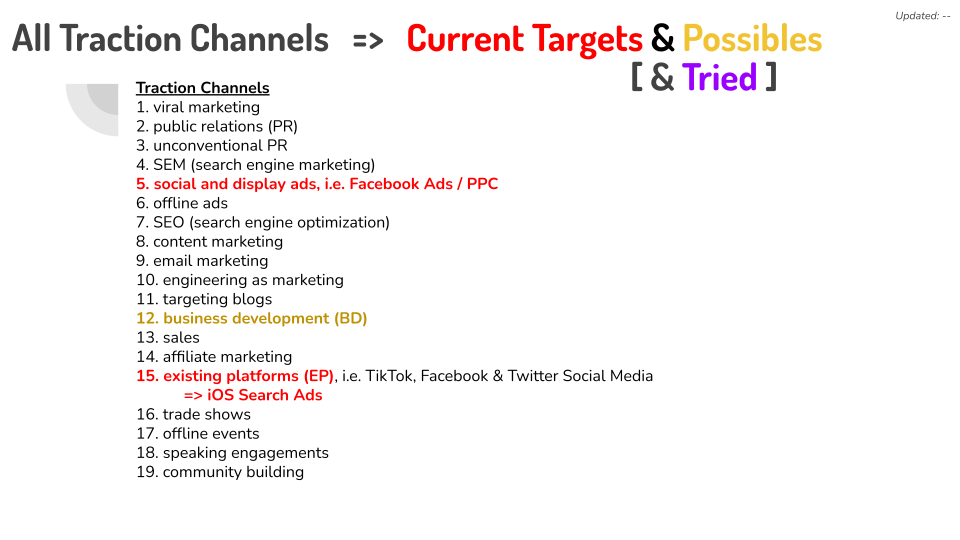
19 Traction Channels:
- viral marketing
- public relations (PR)
- unconventional PR
- SEM (search engine marketing)
- social and display ads, i.e. Facebook Ads / PPC
- offline ads
- SEO (search engine optimization)
- content marketing
- email marketing
- engineering as marketing
- targeting blogs
- business development (BD)
- sales
- affiliate marketing
- existing platforms (EP), i.e. TikTok, Facebook & Twitter Social Media
- trade shows
- offline events
- speaking engagements
- community building
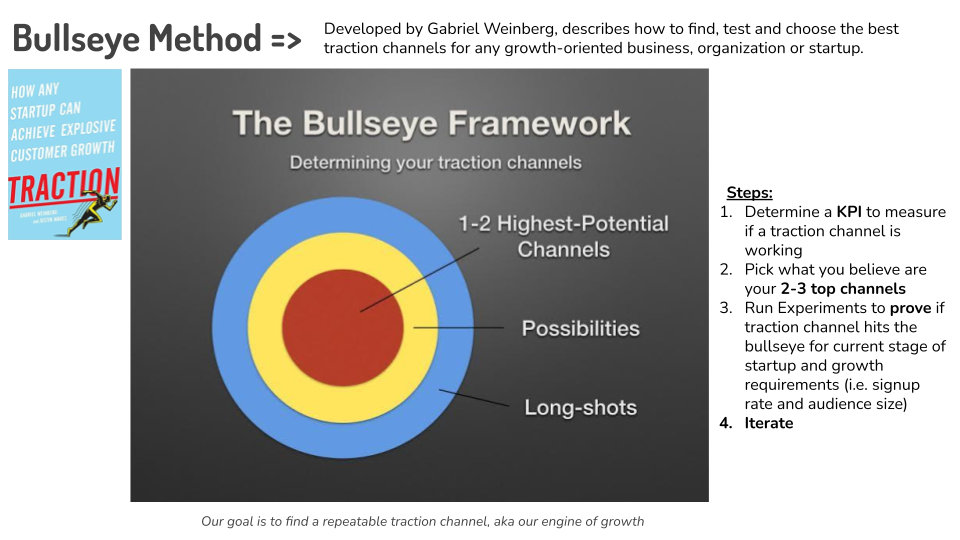
The Bullseye Method is heuristic to help startup growth hackers decide on what are the best traction channels for the size of their business growth stage. It forces you to limit your options and answer key questions to prove the viability of a traction channel and/or growth tactic. I rarely use this method explicitly but it’s an idea in the back of mind.
Where am I on the startup journey?: Ladder of Proof from Nfx
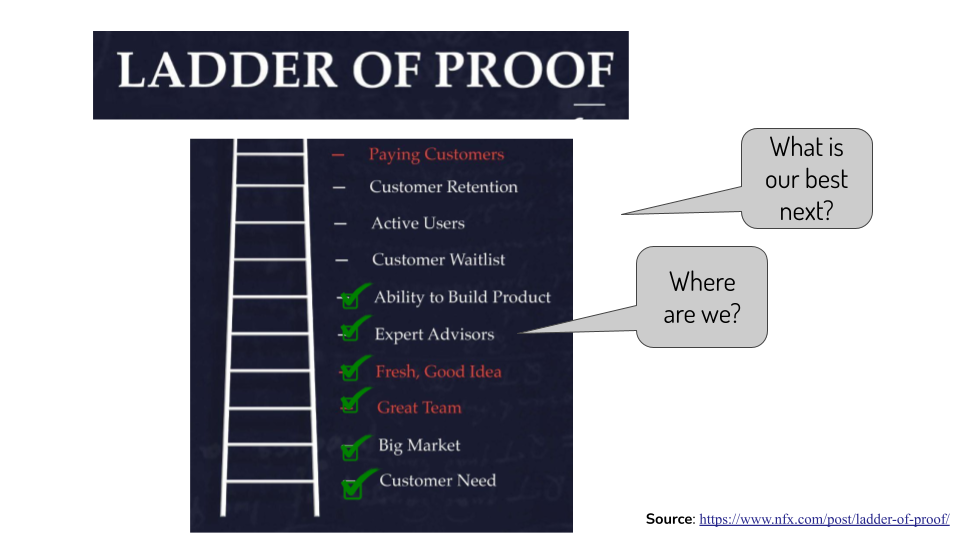
NFX’s Ladder of Proof is a useful heuristic for startups to look at their investment readiness. At the start is the question of a customer need and big enough market. After that are elements like a great team, good idea and expert advisors.
Practically I use this mental model on my own business venture but I also find it a useful framework for clients and startups too, because it give me things to check off as we make key progress on the traction, product and business model.
Conclusion: Utilizing the Growth Hacking Deck for Maximum Impact
For a data-driven growth hacker, what are the two prime currencies or “rewards” to aim for? I believe they are:
- Data-driven Insights - These are the lessons, validations, and conclusions drawn from data. They influence and shape your overarching strategy.
- Scalable, Repeatable Growth - What strategies and tactics can be employed consistently to acquire, activate, and convert paying customers?
In this article, we’ve delved into my prefered tool that encapsulates the pursuit of these twin goals of lesson learned and traction: The Growth Hacking Deck.
🚀 Get the Growth Hacking Deck TEMPLATE for FREE now.
The essence of “Your Growth Deck” lies in tracking, managing, and achieving data-driven insights and scalable growth. At its heart, the Growth Deck acts as both a playbook and scorecard for a startup and company striving to learn, improve and grow. It’s a dynamic blend of strategy and tactics, providing you and your team with a clear direction and means to assess performance. Your essential slides state your goals, give you a quick glance at core metrics and KPIs, and nudge you to iterate, run experiments and grow.
Whether you use this specific slide deck, create your own or even document this iterative process elswhere, some core data-driven growth principles are applicable regardless:
- Iterative Learning and Execution: Your deck and growth process should encourage and enable rapid action-learning cycles targeting a prioritized list of growth channels and opportunities. It’s not about getting it right the first time, but continually trying, getting data, finding insights and acting and optimizing for better and better results.
- Data-Driven Decisions: Decision made should be backed by data. Every experiment should generate data and ideally give you new insights based on data. This not only reduces risk and decreases uncertainty but also ensures you can confidently execute and grow sustainablity.
- Unified Strategy: From tech implementations to leveraging diverse traction channels to constant kaizen and continual improvement, a single working document or deck ensures you are on the same page, up to date on latest experiments, and aligned with the overarching evolving growth strategy.
- Prioritization: With clear metrics and objectives in place, traction experiment slides nudge you to make improvements and iterate on the most meaningful and impactful areas, ensuring resources are spent efficiently and you get the best bang for your “marketing” buck.
The Growth Hacking Deck isn’t just a mere collection of slides; it’s the living essence of your growth vision, efforts and iterative journey towards achieving scaleable, repeatable growth.
By embracing some of its principles and adopting a growth hacker’s mindset, you can hopefully bridge the divide between vision and execution, ensuring that strategies are not merely imagined about but acted upon and learnings are not buried away in spreadsheets and data tools but made available for all to see.
Good luck and happy growth hacking!
AIDA (AI Disclosure Acknowledgement): The following written content was written by me with the assistance of an AI-based system (ChatGPT). Specifically I used it to help me in some aspects of the pre-writing phase, research, copyediting and drafting a few individual points.

